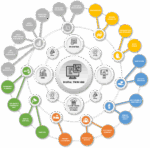
12 Components of a BIM Strategy
During my years at Bain & Company, I spent a significant amount of time developing strategies for a broad range of companies. Behind the façade of crazy slide decks, was a real desire to transform client organizations into market leaders. The process and philosophy are data-driven but ultimately practical. Today more clients approach us at VIATechnik looking for help in crafting their true digital strategy around the built environment and real estate as a service. We’ve established a repeatable framework for transforming their analog and siloed processes into streamlined digital platforms. The end goal? An organization geared to high-velocity and high-impact decision making. Scroll down to learn more.
That framework comprises twelve process touch points:
Understand the business’s strategic goals. Would-be clients approach us seeking a digital twin strategy or BIM strategy. They’re often surprised when we ask them to take a step back to explain what their goals are and how those link to the overall business strategy. But if the proposed BIM strategy that lands on the financial decision-maker’s desk isn’t aligned with the overall business strategy, it’ll be dead on arrival.
Find the stakeholders. Clients often fall into the trap of seeing the organization from inside a bubble. When putting together a list of stakeholders it always pays to err on the side of including more rather than fewer. We’ve developed various stakeholder maps, each one designed for a given client industry. Excluding a critical stakeholder can set the entire strategy back.
Establish a baseline of the organization. It’s easy to focus on the destination and neglect to clarify the starting point. But you can’t prioritize the strategic roadmap without knowing both the endgame and the opening move. Climbing Mount Everest may seem easier if you start from Camp4 instead of Basecamp, but that only means the challenges will be different. Your starting point also determines which tools will be needed.
Interview the thought leaders. Tap into your network to identify the thought leaders and get their opinions. An outsider’s perspective is always valuable. At VIATechnik we call this the Brain Trust – a network of leaders that includes academia, investors, startups, and real estate executives. Each of them have come away from similar journeys with different perspectives that they can share.
Highlight the art of the possible. Clients usually don’t fully engage in the process until they reach the stage that’s the most fun – typically, when they sketch out a picture of the destination. Being able to visualize the outcome rallies team members to march forward. No matter how treacherous the path, an amazing destination will keep the troops motivated.
X-ray the process. Not all process steps can be fun, and this is often the most boring (for all but industrial engineering types). Mapping out the current process and building a true understanding of the Building Information Modeling (BIM) process in the organization is critical to identifying what needs to be updated and where the potential disruptions are.
Craft the pilot. This is critical as it maintains momentum, shows the value early and prevents a massive blow-up once the project is delivered. Other consultants have described nightmare engagements that delivered the end recommendation, only to realize that a key component is missing – usually IT sign-off. It always pays to get people excited by testing the premise with them before launch.
Establish strategic choices. Like kids in a candy store, there is always a team member that wants everything (though it’s never, of course, the financial decision maker). There are always trade-offs in terms of cost, the greatest of which is usually the opportunity cost. By establishing the available choices this will become clear to all.
Build the roadmap. Typically this is the easiest part. Outlining the starting point, the destination, and the strategic choices typically sets one up for success here. If there is a hurdle it’s likely because there is a disconnect between multiple parties. Should this prove to be a challenge, we can help resolve it. Developing a BIM roadmap should never be a difficult process as long as it’s aligned to your digital delivery plan.
Track and incentivize the metrics. Now that a plan is in place, the organization must be willing to establish proper metrics. But if that’s done without incentivizing the organization to follow through by measuring, reporting, and responding to those metrics, it’s like hiring a rent-a-cop – it gives the illusion of security without making a real difference.
Create a communication plan. This goes back to the stakeholders. While the BIM working group is typically small, the network of stakeholders is much larger. It’s always a good idea to over-communicate where the firm is going and proactively prewire for a successful outcome.
Build a program management office. When any large organization is at a stage of transformation, setting up a program management office is critical. It’s the key to driving the change through. It can be easy to fall into the trap of producing a dog-and-pony show that looks good on a resume. But the real opportunity is to drive measurable change into the organization.



